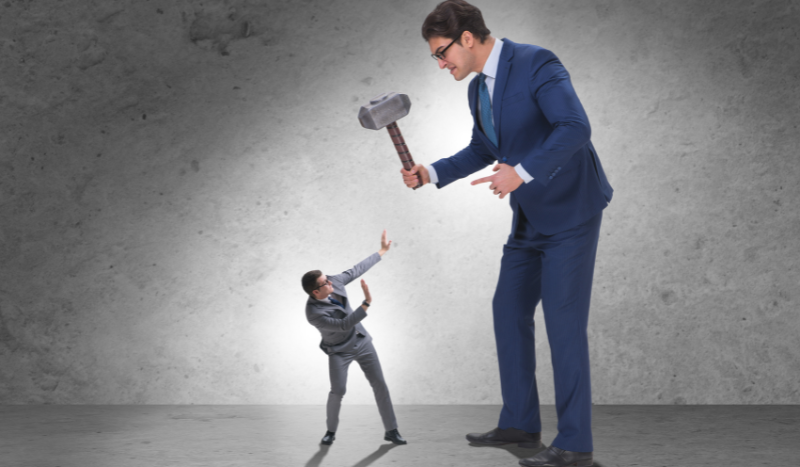Mogging and Height: The Hidden Trauma of Being Short

There are all sorts of cosmetic procedures for aging, body sculpting, fat reduction, etc., to correct perceived imperfections in women. Some are so popular that even men use them to fix their appearances and boost their self-confidence. However, height is a common challenge that men tend to experience more often than their female counterparts. Some people have it; others don't and often wish and dream about it. Then there are those who experience mogging due to their height deficiencies.
What Is Mogging?
Mogging, for those unaware, is a form of bullying that targets people of average or lesser height. It’s an unofficial term for harmful or toxic behaviors exhibited by taller individuals towards those who are less vertically fortunate.
For example, anyone using domineering behavior to mog another is known as a mogger. The victim or person on the receiving end of the toxic behavior is called the moggee. Getting mogged is widely viewed as one of the most embarrassing, demoralizing, and shameful experiences for many people, especially men of average height or shorter. The impact is even more extreme if it occurs in public places or on social media.
The Evolution of Height, Social Acceptance, and Mogging
Since the dawn of time, tallness has been an advantage and a highly desirable and vital trait for the survival of the fittest. All throughout evolution, this perception has remained. As time passed and civilizations evolved, so did the common acceptance of tallness and a distaste for shortness.
According to World Population Review, the United States is by no means the tallest nation in the world; it currently ranks 40th globally. That may seem hard to believe for some, especially when you consider the fact that the average height for women is 5’4 (162.5 cm) and 5’9 (175.26 cm) for men in the country.
Many people who are of average height are quite happy with their stature. They may or may not experience mistreatment or height discrimination. Others are unsatisfied with their current size but are unaware of solutions that may help. Then there’s a growing population of men and women who are crippled by the far-reaching consequences of being short, a condition that is primarily beyond their control. Many people with mismatched limb lengths, physical deformities, and other health conditions that affect proper growth and development become mog-victims.
Signs of Height Mogging
It’s no secret that height often means confidence and power. But when it comes to mogging, confidence and power are often signs of a superiority complex. The urge to dominate individuals with short statures reigns supreme and is toxic. As empowering as it may seem to gloat and showcase superiority over those who are not naturally gifted with tallness, moggers tend to be overly dramatic and toxic individuals. They belittle, harass, and bully others to feel better about themselves.
Height mogging often refers to the following types of behaviors:
- Following victims to dwarf their appearance
- Verbal, written, or visual comparisons that are negative or aggressive towards moggees
- Height shaming
- Overexerting dominance over shorter people
Many people normally struggle with body image and self-confidence issues about their appearance and height. Social media amplifies these effects and makes height a very sensitive and traumatizing subject.
The Impact of Mogging on People With Height Insecurities
Mogging is dangerous. The behavior is extremely toxic, but it can also lead to devastating consequences for those affected and living with mood disorders, such as depression, anxiety, and body dysmorphic disorder (BDD).
According to the Anxiety and Depression Association of America (ADAA), body dysmorphia affects both men and women equally, but preteens and adolescents are highly vulnerable. People suffering from BDD tend to have chronic thoughts about their perceived physical imperfections, leading to negative and self-harming behaviors. Mogging can exacerbate those behaviors and thoughts even in those without mood disorders, making the effects of mogging harder to overcome.
Like height, mood disorders and perceptions are influenced by controllable, uncontrollable, and unknown factors. For moggees, it’s not always easy to get away from negative situations or individuals who seek to make them feel insignificant due to their height. Reminders often permeate their daily lives due to common height stigmas from friends, relatives, and colleagues and discriminatory practices at home, work, school, and in the dating pool.
Money, Power, and Respect. What About Height?
No one, regardless of age, deserves to be disrespected, held back, or mistreated because of their size. Everyone deserves a fair chance at having the money, power, and respect they deserve, including a taller stature. Yet, mogging victims are often on the lower portion of the totem pole and end up with fewer opportunities. To overcome the challenges of having less height, some people use shoe lifts, cushions, and other apparatuses to help conceal their shortcomings and lessen their chances of becoming mog victims. These solutions are often helpful, especially for those with limited financial resources. But they have their limitations.
Height Lengthening Surgery: The Solution to Mogging
Thanks to many advances in medical technology, and some extraordinary surgical skills, Dr. Shahab Mahboubian, D.O, MPH, empowers mog victims and those with height deficiencies with limb lengthening surgery. It’s a minimally invasive procedure that permanently adds up to 8 centimeters in length to the legs to increase height.
When considering the mental and physical challenges associated with height deficiencies and comparing them to the costs and commitment required for height increase surgery, the advantages significantly outweigh the risks. As appealing as the treatment seems, it’s not suitable for everyone. A consultation is necessary for potential patients to learn how the procedure can improve their stature, and self-confidence and help put an end to mogging.


